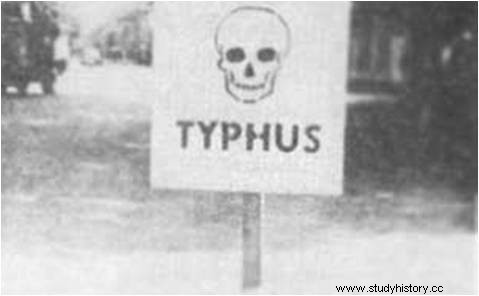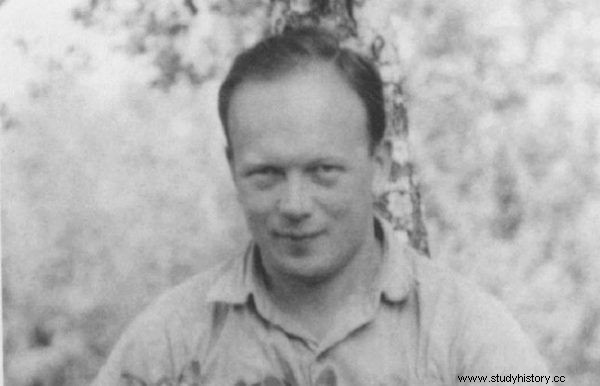Saving lives during the war is a worthy goal - especially if you save not only your own. Eugeniusz Łazowski, a young doctor from Częstochowa, found a surprisingly effective method of deterring aggressors ...
When Eugeniusz Łazowski was finishing his studies, World War II broke out. He was assigned to the Battalion of the Border Protection Corps, a sanitary train was indicated and sent to Brest on the Bug River. He fought - first with the Germans, then with the Soviets; he was captured, but managed to escape from a transport going to Siberia. Later he was arrested by the Germans, he ended up in a POW camp and escaped from it as well. Łazowski was such an efficient fugitive that in November 1939 he married his fiancée Maria Tołwińska, with whom he then left for Rozwadów near Stalowa Wola - here they intended to wait out the war. For the young doctor, however, it was only the beginning of the war vicissitudes…
Terror of the Germans
During World War II, German soldiers feared typhus - possibly even more than bullets. The disease, which was relatively more common in Poland, attacked newcomers from the west who were not naturally immune to it. Typhus, caused by the bacterium Rickettsia prowazekii, is spread by lice. This means it spreads more easily under poor sanitation. War for such bacteria is paradise, and infected troops are useless…

Typhus terrified the occupiers
At that time, the Weil-Felix test, developed in 1916, was used to detect typhus infection. This test uses the fact that Rickettsia prowazekii bacteria react with an antigen obtained from the harmless bacteria Proteus vulgaris, also known as OX 19 Ag. Such a method, despite the more specific tests already developed, is still used today where it is required for economic reasons.
Doctor Stanisław Matulewicz, a colleague of Łazowski, noticed before the outbreak of the war that the Weil-Felix method could be easily deceived. If Proteus vulgaris bacteria enter the patient's bloodstream, the test will be positive and the patient will remain healthy. Łazowski decided to take advantage of this fact ...
Fighting with the fox method
Together with Matulewicz, Łazowski started vaccinating the inhabitants of the vicinity of Stalowa Wola with Proteus vulgaris. He chose those who showed any symptoms of the disease to make his ruse credible. Afraid of being exposed, he did not even inform the patients themselves of his intentions! Additionally, in order to avoid too much attention from the occupiers, the secretive medics assigned some of the vaccinated people to other local doctors.
The Weil-Felix test results, as expected, showed a response characteristic of Rickettsia prowazekii infected bacteria. Łazowski sent the samples to a laboratory under German control so that they could see with their own eyes the extent of the "epidemic". Thanks to this procedure, about 8,000 people from 12 surrounding towns were quarantined, avoiding being sent to labor camps.

Eugeniusz Łazowski saved hundreds of people
Unfortunately, Łazowski's actions could not last too long. Eventually, when the death rate in the Stalowa Wola area remained at a constant, normal level in 1943, the Germans began to suspect a trick. The local Gestapo chief informed the relevant authorities and the commission and the army departed towards the villages.
A show for the Germans
Łazowski did not give up. He gathered the worst-looking elderly patients in one place. At the same time, a party was organized in Rozwadów. When the commission arrived, the doctor invited German specialists to see the sick, warning them that they were dirty and had lots of lice. The senior members of the commission decided not to conduct the inspection for fear of contamination, instead joining the feast; So only younger and less experienced doctors saw the "sick".
The Germans hurriedly collected the samples, looked at the "suffering" and fled. Their tests also gave positive results for infection with typhus bacteria. Rozwadów was not harassed any more, and the quarantine remained in force.
Good doctor
Unfortunately, Łazowski's idea of a false epidemic came too late. Before, together with Matulewicz, they failed to cheat the tests, the Nazis managed to deport the Jewish population to the camps. This does not mean, however, that Łazowski was indifferent to the Jewish cause - he helped the inhabitants of the ghetto whenever he could.
He devised a plan by which he could avoid the death penalty for aiding Jews by meeting them in secret. In order to "make an appointment" with the doctor, the representatives of the chosen people had to hang a piece of white cloth on the fence of their house (adjacent to the ghetto). Seeing such a sign, Łazowski went out at night and gave help to those in need. It quickly turned out that the demand for his services was huge and queues were lining up at the fence.

Łazowski wrote down his memoirs in the book "Private War"
Once again, Łazowski's cleverness was very useful. The Germans required him to keep a strict record of medical equipment and medicines, a large part of which was intended for the treatment of Jews. By a fortunate coincidence, the doctor was often called upon to treat people traveling on trains who stopped at a nearby train station. It was on such occasions that Łazowski recorded a much greater use of medical supplies, leveling the balance.
The clever physician immigrated to the USA in 1958 and settled in Chicago. There he became a pediatrician and lecturer at the University of Illinois. He wrote about his war frauds in a diary published in 1970, and described them in detail later in his 1990 book "Private War".
